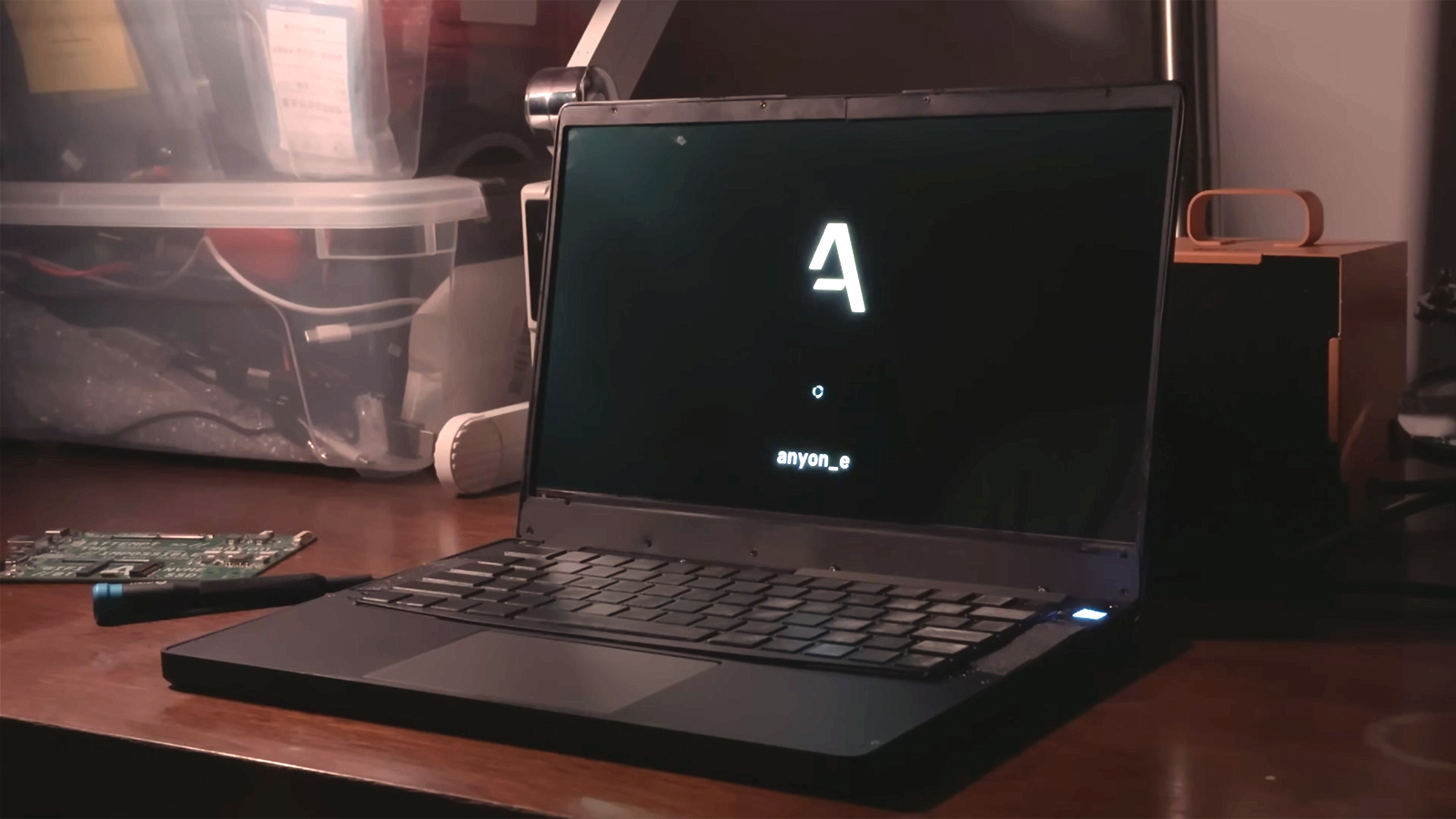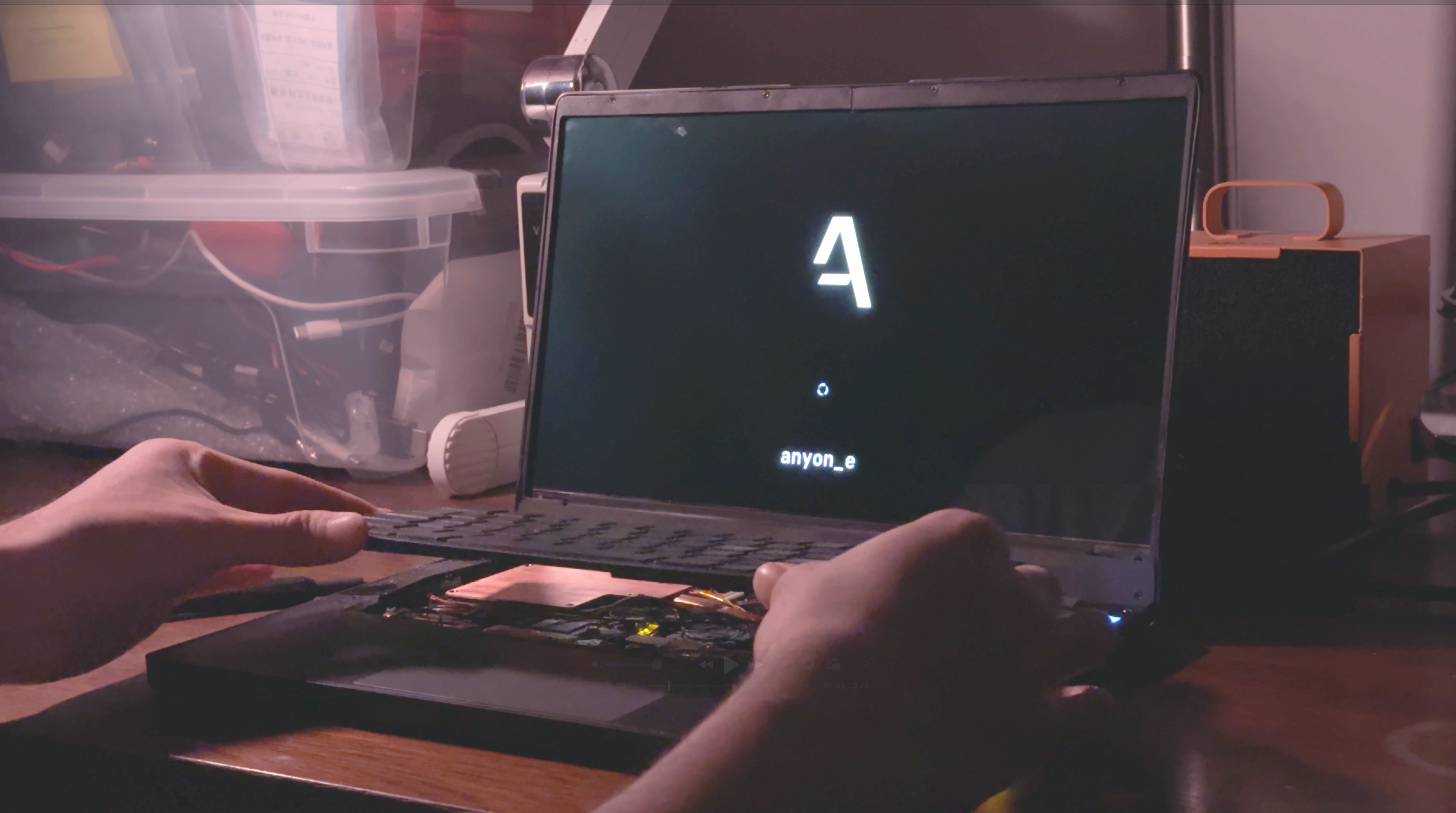Student builds open-source laptop in 6 months — uses 4K AMOLED screen and has 7h battery life

Byran Huang, a senior high school student from the Phillips Exeter Academy, built a fully open-source laptop as his fall term senior project, and it took him just six months to finish it. He called it anyon_e and it features a 4K AMOLED display, a Cherry MX mechanical keyboard, and around seven hours of battery life. According to Huang, he wanted to build a laptop “that hits as many qualities of a modern commercial thin & light laptop—while trying to do as much from scratch as possible.”
He used a Raspberry Pi alternative, the Rockchip RK3588 SoC, which he says is the “fastest consumer-procurable chip on the market”, built into the FriendlyElec CM3588 system-on-a-module with 16GB of LPDDR4X memory. The specifications for the SoC included a quad-core Cortex-A76 and a quad-core Cortex-A55 CPU, a Mali-G10 GPU, and an NPU that outputs 6TOPS. It could also push out 8K video at 60FPS, plus its I/O ports include an 8K display, dual USB3.1, PCIe 3.0 x4, and HDMI 2.1/eDP 1.4. We wonder if the upcoming Raspberry Pi Compute Module 5 16GB will find itself in a similar build?
For the display, Byran used a 13.3-inch 4K Samsung AMOLED ATNA33TP11 display that’s also found on several Asus laptops. Although it may seem like this screen is plug-and-play, Huang soon found out that it was difficult to drive a 4K display over eDP 1.4 because of signal integrity issues. After a few tests and calculations, he discovered that shortening the length between the CPU and display solved it, which finally allowed his screen to work.
The laptop’s keyboard was built using Cherry MX ULP mechanical switches on a separate removable case that can be used as a separate wireless keyboard. But despite this functionality (which meant the keyboard required its own 200mAh battery and SoC), he was able to maintain a height of under 7mm to keep it nice and compact. As for the mouse, anyon_e is equipped with the Azoteq PXM0057-401 glass surface and multi-touch trackpad that worked over USB; and it only cost Huang $35.

Aside from these things, he also acquired several parts like the batteries from AA Portable Power Corp. in California, and screen hinges from the Framework Laptop 13. He also used Joshua Riek’s ubuntu-rockchip kernel/distro, which made it a lot easier to have a working operating system on the anyon_e because of its great out-of-the-box experience and optimizations. However, Byran still had to build some things from scratch himself. This included the laptop’s mainboard and its CNC aluminum chassis, plus a few small 3D printed plastic structural parts to give the laptop stability.
In the end, Byran was able to create a sleek and polished laptop that could compare against other flagship devices created by Asus and Apple that cost several thousand dollars. The anyon_e laptop could even boot three seconds faster than Huang’s own MacBook Pro, which is already a tightly integrated device. And since this is an open-source project, the laptop is not hiding any secrets underneath—anyone with the knowhow, equipment, and grit to follow his process could recreate the anyon_e.
Get Tom's Hardware's best news and in-depth reviews, straight to your inbox.

Jowi Morales is a tech enthusiast with years of experience working in the industry. He’s been writing with several tech publications since 2021, where he’s been interested in tech hardware and consumer electronics.
-
ezst036 Its criminal that all these parts aren't standardized and freely-ready off the shelf with numerous different laptop-intended motherboard, laptop case, laptop power supply, and laptop monitor options.Reply -
stonecarver Brian Huang if you ever bump into this thread on Tom's just want to say great job. :)Reply -
prayforsurfinfl Reply
Wait a couple of days and then check Amazon. There's probably half a dozen potential sellers right now putting together kits that will duplicate Student Brian's project.Admin said:Student Brian Huang builds a fully open-source laptop in six months as part of his senior school project.
Student builds open-source laptop in 6 months — uses 4K AMOLED screen and has 7h battery life : Read more -
abufrejoval I'd say that's a pretty good job application as a laptop designer.Reply
But the media production ability of this generation is also really awsome, the video was both impressive and fun!
As to the Rockchip, much like the Raspberry PI5 it's really not a good match for a laptop design and by now just too old and slow to be really attractive in a notebook. I got an RK3588 based Orange Pi 5+ with 32GB running Debian and Proxmox on a 4k screen (in a cluster with an RP5), but GPU accelleration is only offered with Ubuntu and support is really stagnating: Rockchip seems either understaffed or busy elsewhere (sanction resilient RISC-V?).
Turns out they were quite busy with new hardware form factors: newer variants such as the RP5 ultra offer MIPI DSI TX 4 lane interfaces that can directly be used to attach display panels. And there is the compute module with a tablet variant base board, which also breaks out the full set of MIPI ports the OP5+ variant didn't, so his efforts would be much reduced today if he started with that.
Too bad phone SoCs have ditched many of the parts laptops still need and there really isn't any SBC or compute modules except outrageously priced development boards. I've long hoped for Huawei to come up with an updated Kirin based board with Linaro, but they got blacklisted instead.
Of course there are Nvidia (Orion?) chips and baseboards, that would have been much more powerful. And perhaps the Samsung XR SoCs (e.g. Quest 3) would deliver what the phone SoCs are missing, so claiming the "fastest available chip" clearly omits the "" clause, same reason I got the OP5+, which is very comparable to Jasper Lake Atoms in every which way, including price.
I guess the most impressive part of this project was to show that doing such a one-off PCB and chassis design using service companies was feasible on a money and time budget where he didn't resto-mod a car instead. Economically it's still insane given what you can get for €500-€1000 new these days, so I don't really expect many imitators, let alone mass production.
But this evidently was an engineering thesis and job application and I'm pretty sure it got him an A+, if not a job, too. -
abufrejoval Reply
I'm pretty sure Framework analyzed the RK3588's potential and the fact that they onle came up with an even slower RISC-V variant is because that at least has some (developer) unicorn potential.ezst036 said:Its criminal that all these parts aren't standardized and freely-ready off the shelf with numerous different laptop-intended motherboard, laptop case, laptop power supply, and laptop monitor options.
"Criminal" hints at conspiracy, which is way too popular these days, but in this case at worst vendor marget segmentation; but mostly reflects low attraction in a crowded market where scale is everything.
And as much as I like Framework in theory, I still prefer to buy the same capabilities at less than 50% price baked into a fixed device that I can sell or give away. But then so far only one out of perhaps 30 notebooks has ever died on me: after ten years of service.
And if your "criminal" referred to ecology, I'm not convinced that Framework can make much of a difference. The main eco debt is still in chip manufacturing and there the Chinese selling resoldered RAM, mainboards or GPUs might actually be doing better, even if ecology is the least of their motivations.
